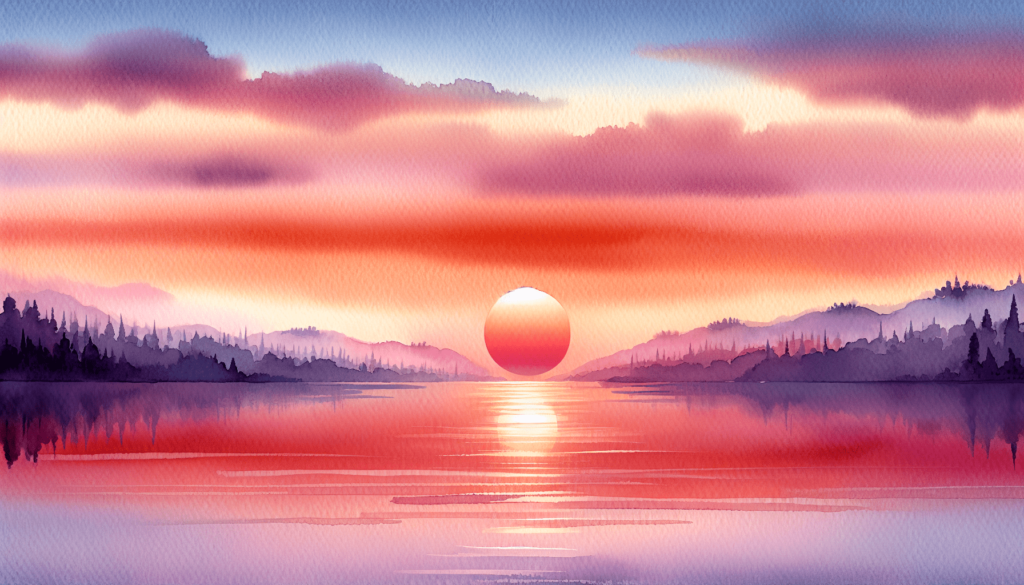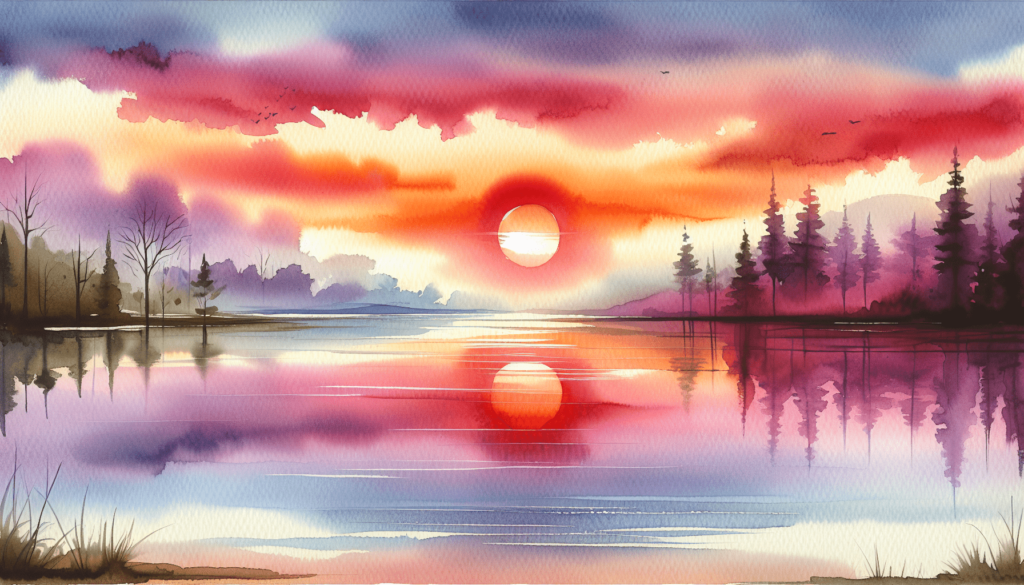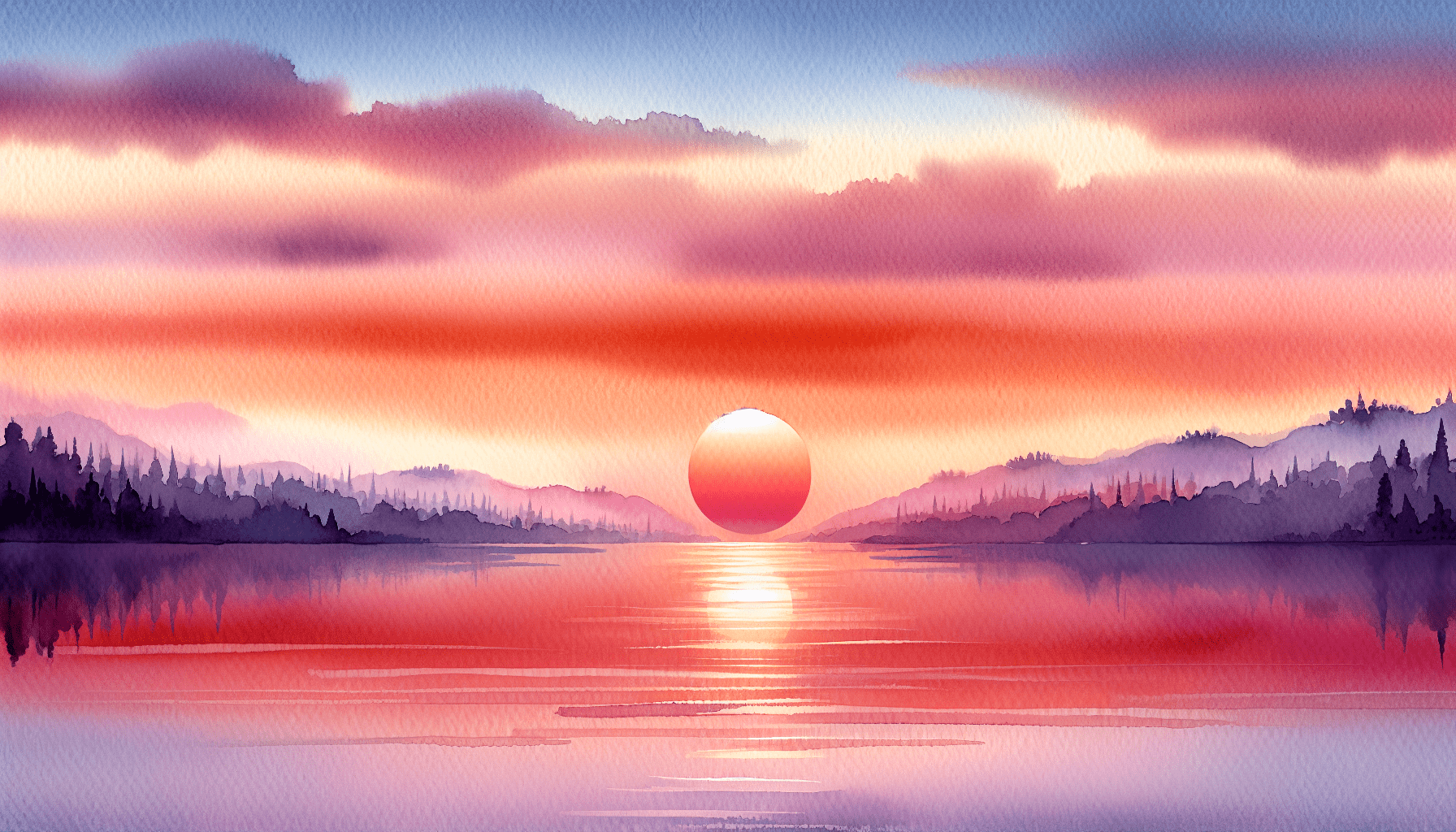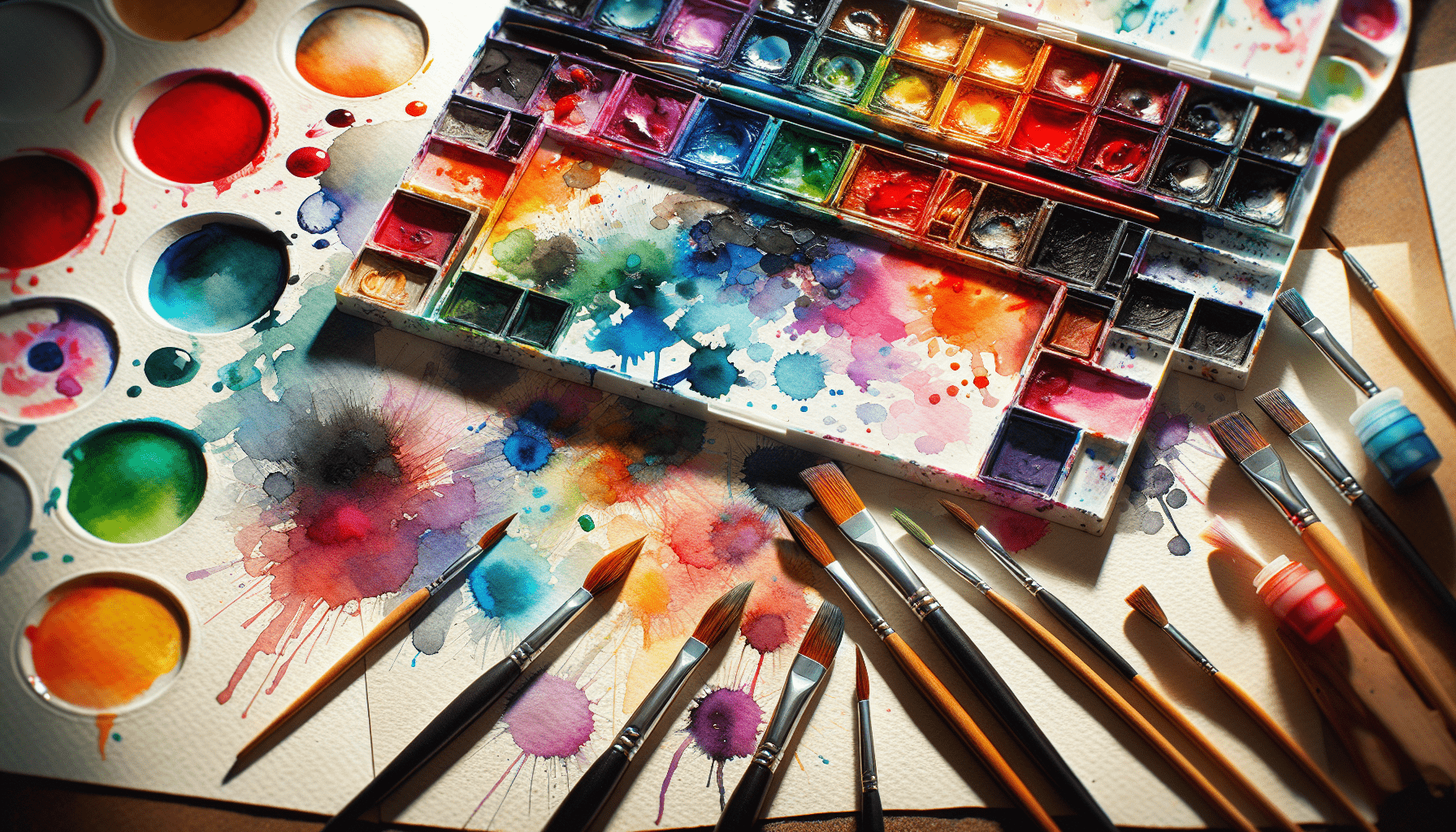Creating a breathtaking sunset with watercolors requires a blend of technique, precision, and artistic vision. In “How To Paint Watercolor Sunset,” you will be guided through each step of this creative process, from selecting the right materials to mastering brushstrokes and color blending. This article will provide you with detailed instructions to help you capture the vibrant hues and subtle gradients of a sunset, bringing the serene beauty of nature to your canvas. Whether you are a novice or an experienced artist, this comprehensive guide will enhance your watercolor skills and inspire your artistic journey. Have you ever wanted to capture the breathtaking beauty of a sunset in a painting? The warm hues blending together as the sun dips below the horizon can be truly mesmerizing. Painting a watercolor sunset can be a rewarding experience, allowing you to express your creativity and bring a piece of nature’s beauty into your artwork. With the right techniques and a bit of practice, you can master the art of painting a stunning watercolor sunset.

Understanding Watercolor
Watercolor is a popular medium due to its unique properties and versatile applications. Unlike oil or acrylic paints, watercolors offer a translucent, luminous quality that makes them perfect for depicting the delicate variations of a sunset. However, watercolor painting requires a different approach and technique.
Key Characteristics of Watercolor
Watercolors are known for their fluidity and transparency, making them ideal for layering and creating gradients. The following characteristics are essential to keep in mind:
| Characteristic | Description |
|---|---|
| Transparency | Watercolors allow light to pass through them, creating a luminous effect. |
| Layering | Applying multiple layers can create depth and dimension. |
| Fluidity | The paint easily spreads and blends with water, which can be both challenging and rewarding. |
| Unpredictability | The paint’s ability to move and mix on the paper can result in unexpected and beautiful effects. |
| Quick Drying Time | Watercolors dry relatively quickly, which requires swift decision-making while painting. |
Materials You Will Need
To create a beautiful watercolor sunset, you’ll need some essential materials. The quality of your materials can significantly impact your painting’s outcome, so it’s important to invest in good supplies.
Basic Materials List
| Material | Description |
|---|---|
| Watercolor Paints | High-quality paints in various colors, especially warm hues like yellows, oranges, reds, and purples. |
| Watercolor Paper | Thick, cold-pressed paper that can handle multiple layers of paint and water. |
| Brushes | A variety of brushes including round, flat, and detail brushes. |
| Palette | For mixing colors. |
| Water Containers | At least two containers: one for clean water and one for rinsing brushes. |
| Paper Towels/Tissues | For blotting excess water and paint. |
| Pencil and Eraser | For drawing your initial sketch if needed. |
| Masking Tape | To tape down your watercolor paper and create clean edges. |
| Table Easel or Flat Surface | For securing your paper and maintaining a comfortable painting position. |
Preparing Your Workspace
Before you begin painting, it’s essential to set up your workspace to ensure a smooth process. A well-organized and comfortable workspace can significantly enhance your painting experience.
Setting Up Your Workspace
Follow these steps to prepare your painting area:
- Choose a Well-lit Area: Natural light is best, but you can use a good quality lamp if needed.
- Organize Your Materials: Arrange your paints, brushes, water containers, and paper within easy reach.
- Tape Down Your Paper: Use masking tape to secure your watercolor paper to a flat surface or easel. This prevents warping when the paper gets wet.
- Prepare Clean Water: Have at least two containers of water ready—one for rinsing brushes and one with clean water for mixing paints.
- Have Paper Towels Handy: Keep paper towels or tissues nearby for blotting brushes or fixing mistakes.
Choosing Your Colors
Selecting the right colors is critical in recreating the vivid hues of a sunset. The choice of colors can evoke different moods and feelings in your painting.
Recommended Colors for a Sunset
A typical sunset palette includes a range of warm and cool colors:
| Color | Use |
|---|---|
| Cadmium Yellow | For the bright, warm areas closest to the sun. |
| Cadmium Orange | To blend with yellow and create a softer transition toward the deeper colors. |
| Alizarin Crimson | For the intense red hues that occur during a dramatic sunset. |
| Ultramarine Blue | To create the cool tones of the sky away from the sun. |
| Payne’s Gray | To add depth and contrast, especially for darker areas and silhouettes. |
| Viridian Green | Optional, for adding subtle cool tones in the lower part of the sky. |

Basic Techniques
Understanding basic watercolor techniques will be highly beneficial as you begin to paint. These techniques will help you achieve the desired effects in your sunset painting.
Wet-on-Wet Technique
This technique involves applying wet paint onto wet paper, allowing colors to blend naturally and create soft transitions. It’s excellent for painting the sky and clouds where smooth gradients are needed.
Wet-on-Dry Technique
In this technique, you apply wet paint onto dry paper, resulting in more defined edges and sharper details. This method is useful for adding details and focal points in your painting.
Layering and Glazing
Layering involves applying multiple washes of color, allowing each layer to dry before adding the next. This builds depth and complexity in your painting. Glazing is a form of layering where you apply a translucent layer of color over a dry one, altering its appearance without masking it entirely.
Lifting and Blotting
Lifting involves removing paint to create highlights or correct mistakes. You can lift color using a damp brush or a clean, dry paper towel. Blotting is similar but usually done to remove excess water or paint while it’s still wet.
Step-by-Step Guide to Painting a Watercolor Sunset
Now that you have your materials ready and understand basic techniques, it’s time to dive into the painting process. Follow these steps to create your own watercolor sunset.
Step 1: Sketch the Composition
Begin with a light pencil sketch of your composition. Focus on the horizon line, the sun’s location, and any additional elements like clouds or silhouettes. This sketch will act as a guide for your painting.
Step 2: Wet the Paper
Using a large brush, wet the entire paper with clean water if you’re aiming for a soft, blended sky. Be careful to avoid puddles; the paper should be evenly moist. This prepares your surface for the wet-on-wet technique.
Step 3: Apply the Initial Wash
Start by applying the lightest color first, usually cadmium yellow, around the area where the sun is located. Gradually blend in cadmium orange as you move away from the sun. Let the colors mix naturally on the wet paper to create smooth gradients.
Step 4: Introduce Warmer Hues
While the paper is still wet, add alizarin crimson around the edges of the orange area. This adds depth and intensity. If desired, add a touch of ultramarine blue or viridian green to the outer edges of the sky, blending seamlessly into the reddish hues.
Step 5: Paint the Sun
Once the initial wash is dry, paint the sun using a more concentrated cadmium yellow. You can also lift some paint from the sun’s center to create a glowing effect.
Step 6: Add Details
Using the wet-on-dry technique, add any clouds using a mixture of ultramarine blue and Payne’s gray. Apply these strategically, keeping in mind how clouds catch and diffuse light. Use a fine brush to add details like silhouettes of trees, birds, or other elements.
Step 7: Final Touches
Review your painting and make necessary adjustments. You might want to reinforce certain colors or add more details. Once satisfied, let your painting dry completely.
Advanced Techniques
If you’re looking to elevate your watercolor sunset paintings, consider incorporating advanced techniques to add more complexity and depth.
Using Masking Fluid
Masking fluid can be used to preserve white areas or light values in your painting. It is beneficial for maintaining intricate details or bright highlights that you don’t want to paint over.
Experimenting with Salt
Sprinkling salt onto wet paint creates unique textures, resembling the granular look of certain sky elements. As the salt absorbs water, it creates interesting patterns and can add a dynamic aspect to your skies.
Incorporating Gradient Washes
Gradient washes can be used to create seamless transitions between hues, adding to the atmospheric perspective. Practice achieving smooth gradients from one color to another to enhance your sunsets.
Troubleshooting Common Issues
Even experienced painters encounter challenges while working with watercolors. Here are some common issues and tips for resolving them.
Uneven Washes
If your initial wash looks uneven, try rewetting the area and gently blending the paint with a clean, damp brush. Make sure your paper isn’t too wet or too dry before reapplying paint.
Hard Edges
Hard edges can form when paint dries too quickly. To fix this, dampen the edge with a clean brush and gently blend it into the surrounding area. Practicing the wet-on-wet technique can also help manage this issue.
Muddy Colors
Mixing too many colors can result in muddy hues. Stick to a limited palette and practice blending colors on a separate sheet of paper before applying them to your painting.
Practice and Patience
Mastering watercolor painting, especially something as dynamic as a sunset, requires practice and patience. Don’t be discouraged by initial setbacks. Each painting is an opportunity to learn and improve.
Regular Practice
Set aside time regularly for painting. Consistent practice helps you understand how the paint behaves and improves your control over the medium.
Learning from Mistakes
Don’t be afraid to make mistakes. Analyze what went wrong and how you can improve in your next attempt. Sometimes unexpected outcomes can lead to beautiful results.
Seeking Feedback
Share your work with fellow artists or mentors. Constructive feedback can provide valuable insights and help you grow as an artist.
Conclusion
Creating a watercolor sunset is a delightful way to practice your art skills while capturing the beauty of nature. By understanding the unique properties of watercolors, preparing the right materials, mastering basic techniques, and following a step-by-step process, you can achieve stunning results. Remember to be patient with yourself and enjoy the process of creating art. With time and practice, you’ll be able to paint watercolor sunsets that are truly captivating.



